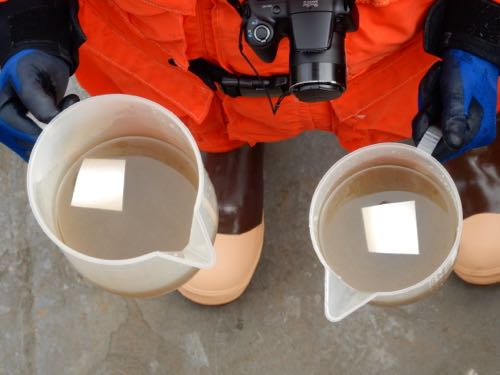While we have been transiting, each science team has been checking and setting up its equipment in preparation for the first station. The bird and marine mammal teams have also been keeping watch. While it may seem like a lot of down time during the transit, it has actually been quite busy. In addition to microscopes, screens and nets, a range of probes and other specialized devices will be used during the science stations.
The box corer will be used to collect samples of sediments. This large piece of equipment is lowered into the sediment, and then a flat "shovel" scoops and closes the bottom to collect the sample. These samples will be divided and analyzed for both physical characteristics such as partical size and composition as well as organisms.
 The box corer is being raised after collecting a sediment sample.
The box corer is being raised after collecting a sediment sample.
The unmanned ROV will be deployed to provide a visual of life below the surface as well as to collect samples of organisms and bring them back to the ship for analysis.
 The unmanned ROV will help scientists see organisms in the environment.
The unmanned ROV will help scientists see organisms in the environment.
Microscopes are set up and ready for whatever may be collected, and the multiple types of nets are ready to be deployed. A test run of the box corer, CTD, and bongo nets is scheduled for today so the scientists on board Healy will know that the equipment they plan to use is prepared.
 The bongo nets will collect plankton when deployed.
The bongo nets will collect plankton when deployed.
Water passes through the net, and organisms are funneled into collecting containers. A meter at the top of the net measures water flow; i.e. liters, so population estimates may be made. Here is a look at today's collection during the test run.
 Today's test collection.
Today's test collection.
The CTD collects conductivity, temperature, and depth data, and water samples may also be collected. You can see the collection bottles as the CTD is lowered over the side of the ship. The collected water is divided among those research teams needing water samples.
 The CTD is lowered over the side of the ship.
The CTD is lowered over the side of the ship.
Q and A
Will the box corer sample pelagic or benthic organisms?
Answer from last Q: Glacier-fed waters have a milky appearance because of the silt and particulates that are carried into the water.


Comments